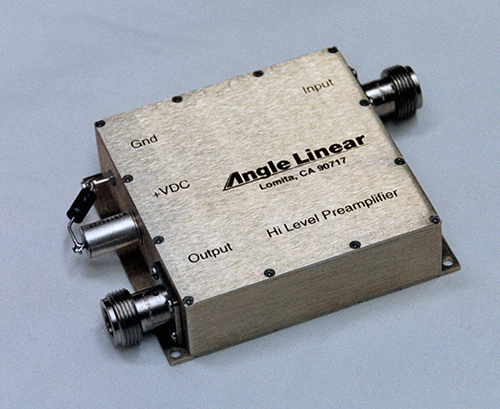Improving Communications Systems
Orbital and flight test long range communications received a high-frequency boost at Dryden Flight Research Center after the NASA center approached Angle Linear of Lomita, California.
The Space Shuttle has many communications systems which are used throughout a typical mission. Voice communication with the Shuttle is usually maintained on S-band and ultra-high frequencies (UHF). While standard GRC-171 radios that operate in the UHF range are extensively used throughout the world, they were not designed for long range communications. In particular, the sensitivity of these UHF radios needed to be enhanced to pick up the weak signals of spaceborne vehicles and distant terrestrial communications.
Given that the radio spectrum has become increasingly congested, the ability to hear extremely weak signals requires greater receiver sensitivity. Receivers must exhibit a high dynamic range and an ability to operate in the presence of many other strong signals without being overwhelmed by interference.
Dryden Flight Research Center was using externally mounted antenna preamplifiers to solve the problem. But, this solution limited the system usage to single frequency STS operations. Dryden realized that a preamplifier mounted inside of the radio could provide the required gain for STS operations while allowing the multimillion dollar tracking communications system to also be used to provide communications for local flight test operations.
Angle Linear is a manufacturer of linear radio frequency products and peripherals for communications. The company specializes in preamplifiers, receiver front end filtering and receiver multi-couplers for a variety of communications applications. In business for some two decades, the group had long supplied research and development and production equipment for business, cellular, aerospace, radio astronomy and amateur needs.
Angle Linear set about the task of solving Dryden's quandary. "This is where Angle Linear provided its unique service," said Michael Yettaw, work leader of the Dryden Communications Facility. "Large manufacturers of preamp products are generally not interested in manufacturing small quantities of custom designed equipment." He also said that companies like Angle Linear that build small quantities of unique equipment to NASA specifications provide a service crucial to research and development.
The solution was a receiving preamplifier specially crafted for NASA and the GRC-171 radio. The results were dramatic, recounts Angle Linear's Chip Angle, general manager and owner of the company.
Substantially better sensitivity than ever before was achieved, and without any interference. Communications with the Space Shuttle is now much more reliable, especially on orbits where the UHF antennas are not in the best of orientation relative to the ground site. NASA Dryden could now carry out reliable communications with the Shuttle on UHF, even from a distance of 3,000 miles as the space plane flew over the Atlantic Ocean. Additionally, Dryden could support local missions without purchasing additional equipment.
The success story has carried over to other NASA projects underway at Dryden, such as the Mir Space Station communications support effort. The preamplifier system is also currently under evaluation by other NASA centers.
For Angle Linear, the NASA fix turned profitable as a very sensitive, high dynamic range amplifier for the commercial communications industry. A preamplifier line was greatly expanded to cover a broader range of frequencies, providing the same sensational improvement to other areas of communications. These include business, government, trucking, land mobile, cellular and broadcast.

Originally developed for NASA Space Shuttle communications, Angle Linear's receiving preamplifier has a very sensitive high dynamic range. The system is used in a variety of communications applications, including business, government, tracking, and cellular.













